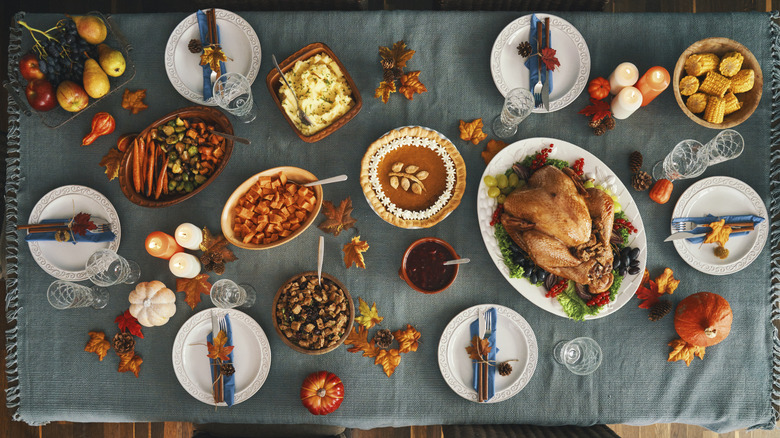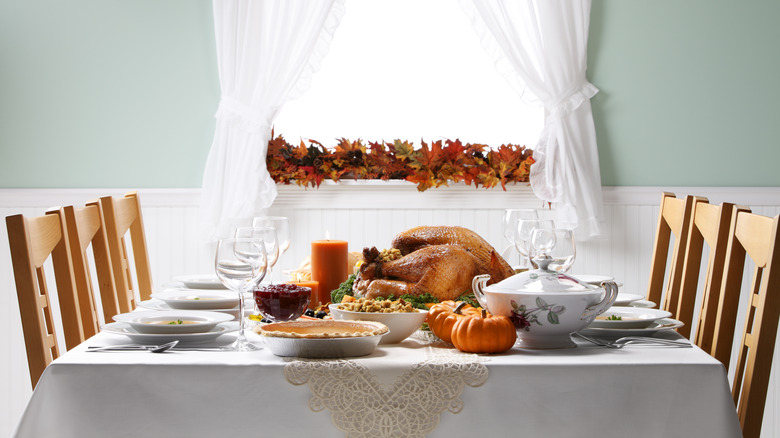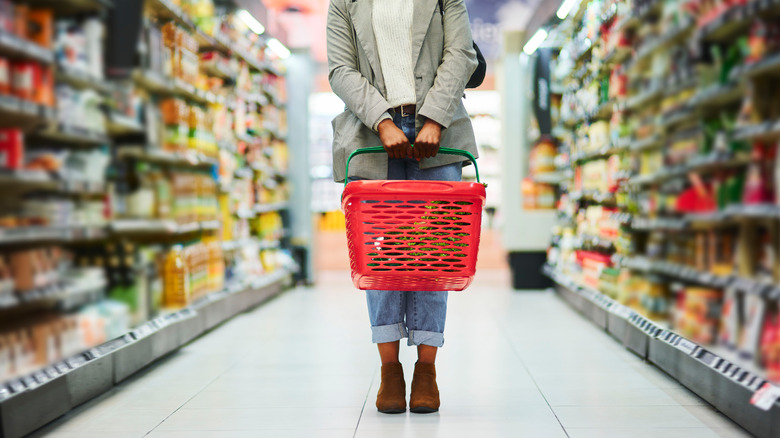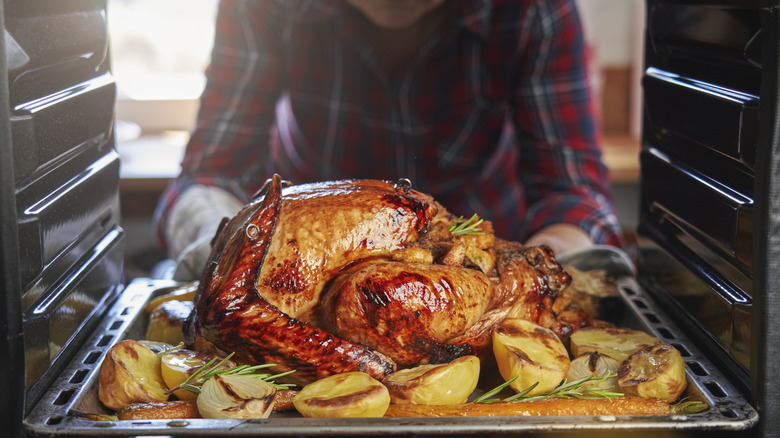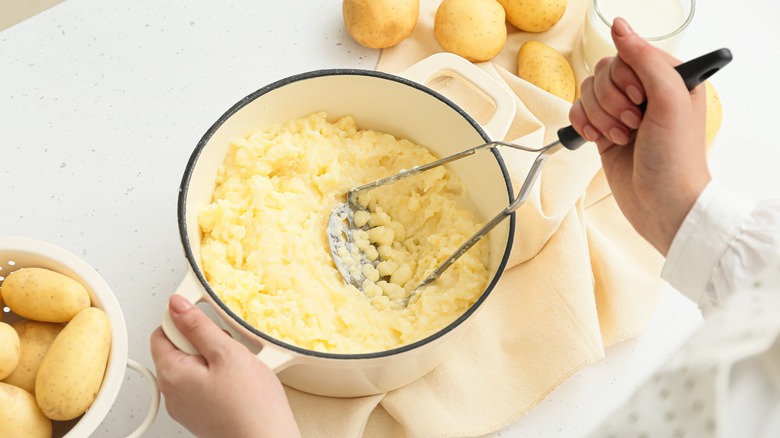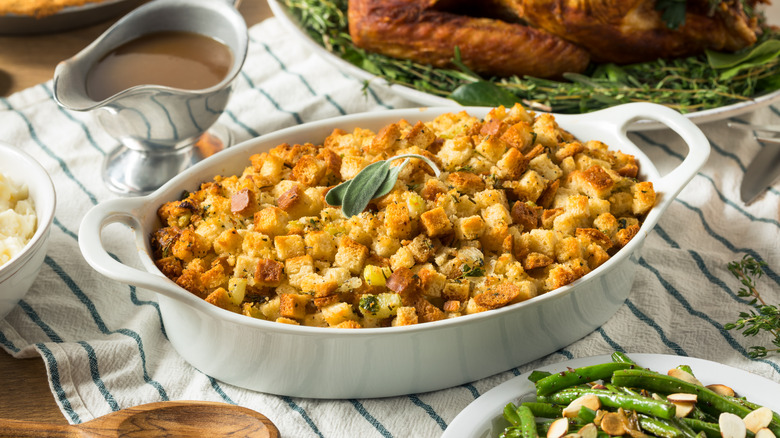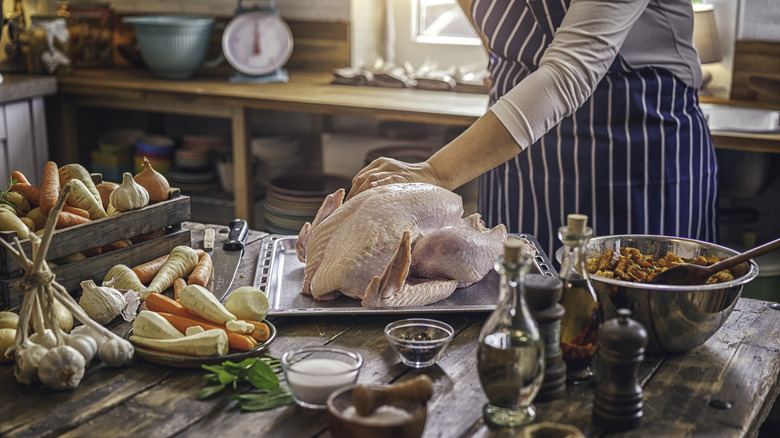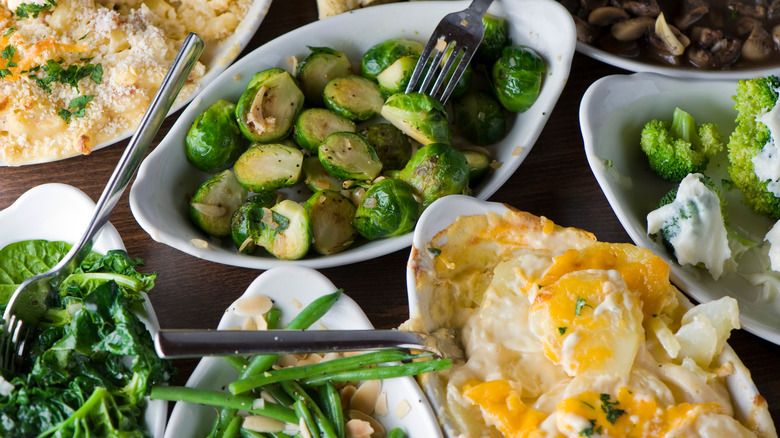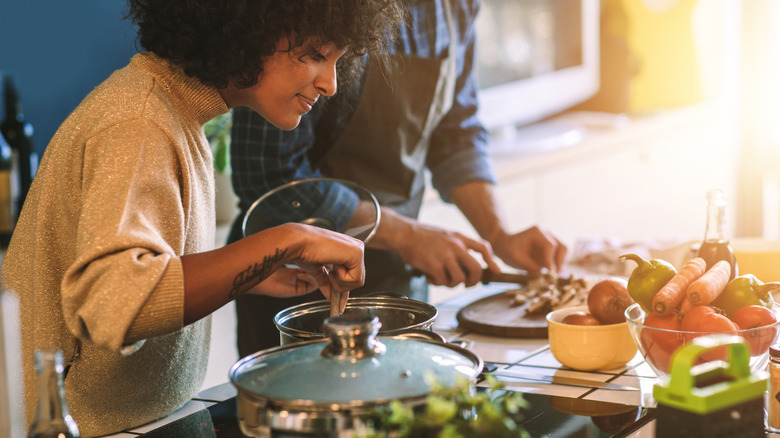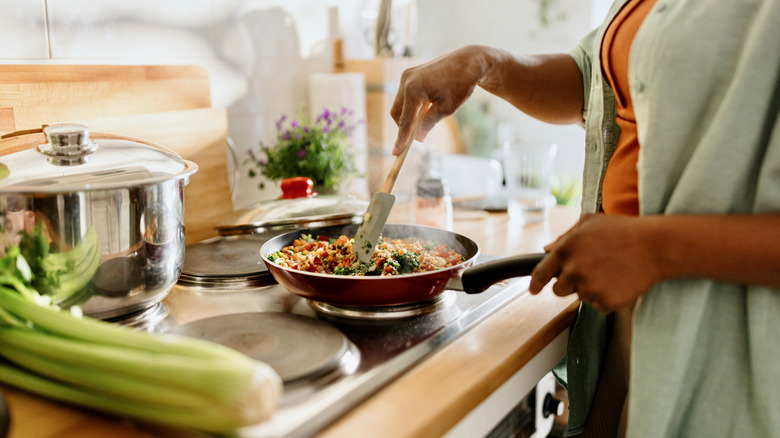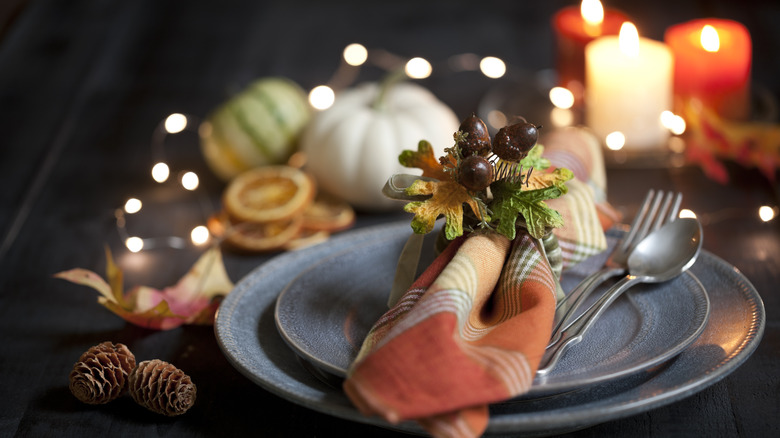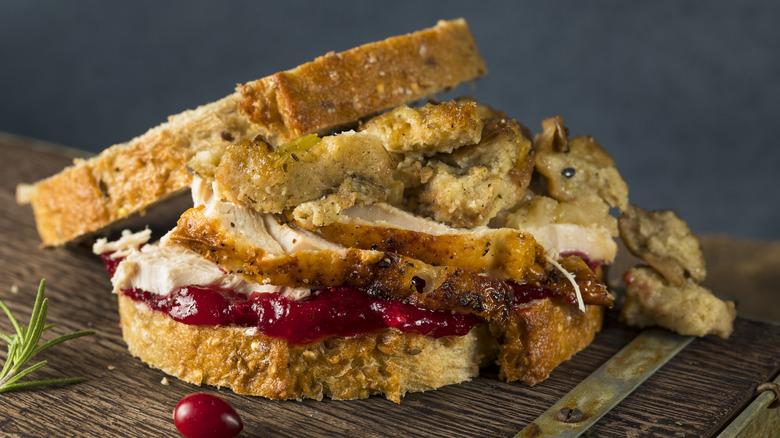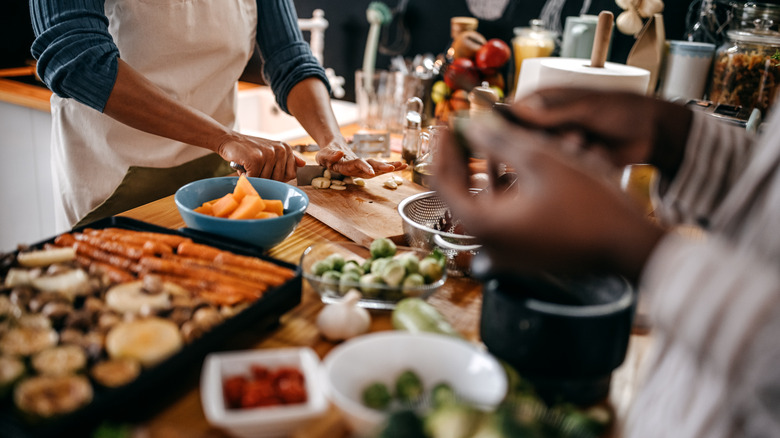12 Common Mistakes People Make When Preparing Thanksgiving Dinner
It's that time of year again when families and friends get together to celebrate all the ways they're grateful, from love to health to friendships. Thanksgiving is the time to share with others and break bread in the spirit of community. Unfortunately, a classic Thanksgiving feast can be challenging to put together. Many people have never actually roasted a whole turkey before, and classic stuffing takes a few tries before finding the balance between soggy and dry. Preparing a full Thanksgiving dinner is a big enough endeavor that it can be intimidating to even experienced home cooks. Overall it's quite the task to take on, and you want to get it right.
There's a lot of planning and prep that goes into the traditional Thanksgiving meal, and chances are that if you've hosted Thanksgiving before, then you have fallen prey to some of these classic mistakes. If it's your first time hosting turkey day, you might not even be aware of the common errors people make when preparing a full dinner spread. Here, in the spirit of sharing, we share some of these mistakes so you can avoid them and have a low-stress hosting experience. You may even get so good at it that you'll want to host again next year.
1. Not making a guest list
The first step in hosting a Thanksgiving dinner is to make a guest list. Making a feast takes proper planning, and you need to know who you're cooking for and how many people are coming. A guest list helps you pin down portions and plan for the size of the turkey and how many side dishes and appetizers you'll need.
On top of that, many folks have dietary restrictions and concerns. While you don't have to cater to everyone's whim, you do want to be a good host and make sure you have something everyone can eat. Think vegan or vegetarian options, or gluten-free dishes for friends or family on gluten-free diets or who have celiac disease. We aren't suggesting you have to make a tofu turkey (although you can), but just make sure that the table is welcoming for everyone even with dietary conditions. If you're really stumped, ask your guests what they prefer. Some people with food allergies, especially severe ones, may prefer to bring their own dishes.
2. Waiting too long to shop
You do not want to procrastinate on shopping for Thanksgiving dinner supplies. The stores are crowded with stressed and cranky shoppers trying to get everything on their lists. Parking lots are full. The whole experience is exhausting. But it doesn't have to be — many of the things you need can and should be purchased early before the multitudes of last-minute shoppers barrel through the store. Items like bags of dried bread cubes for stuffing, potatoes for mashing, fried onions for green bean casserole, and dried herbs and seasonings have a long shelf life, and you can beat the crowds and the possibilities of empty store shelves by shopping early. According to Google Trends, the worst time to go to the supermarket is on the Wednesday before Thanksgiving, between 5 and 6 pm, and if you need to hit up the liquor store, you should avoid picking up your bottle at 6 pm on the night before the big day.
Even the Tuesday before isn't early enough, and the author of "Grocery: The Buying and Selling of Food in America," Michael Ruhlman, advises against doing any shopping at all on the Tuesday before Thanksgiving because this is also a terrible day to shop. Instead, plan and get your goods a week before the big day. If you're special ordering a turkey or dessert, you'll want to put your order in up to a month early to make sure you can get your items.
3. Misunderstanding turkey math
Roasting an entire turkey requires some math. First, you have to figure out how much turkey you need. The general rule of thumb is one pound of turkey for each adult and half a pound for each child. This seems a little conservative for some, and they opt for one and a half pounds per adult. If you want to have leftovers — and who doesn't? — you can up it to two pounds per adult.
Most families choose a frozen turkey for their Thanksgiving feast. It's cheaper than fresh and widely available, but improperly defrosting a frozen turkey is one of the biggest Thanksgiving mistakes that can ruin the whole meal. You can't simply leave the bird on the counter to defrost overnight. A whole frozen turkey takes days to defrost, and it must be done in the refrigerator. Butterball explains that it takes one day to defrost four pounds of turkey this way, so a twenty-pound turkey needs to defrost for five days. Don't forget to put it in a pan so raw turkey juice isn't dripping into your refrigerator.
The last bit of turkey math is cooking time. The trick to cooking a turkey is to keep it low and slow. Experts recommend cooking at 325 degrees Fahrenheit. An unstuffed twenty-pound turkey needs between three and a half to four hours to cook, while a stuffed turkey will need an additional hour — but you should rethink stuffing the turkey as, for food safety reasons, the USDA advises against it.
4. Over-mashing the potatoes
Mashed potatoes are hands down one of the Thanksgiving dishes that everybody loves. It's one dish that even picky kids will eat at Thanksgiving, and the perfect thing to drown in savory gravy. So you want to get this one right, and over-mashing potatoes is a surefire way to get them too starchy; potatoes become gummy because there's too much starch. You can remove excess starch by soaking the potatoes before boiling them and rinsing them afterward.
The next step is really the key to keeping that starch at bay — you should use a hand masher, ricer, or food mill to cream those spuds. Avoid using the blender or food processor because it will make them too gluey, with a dense texture. Ironically, the best potatoes to choose for mashed potatoes are the starchy ones like russet, Yukon, or Idaho spuds. These floury potatoes will yield a light, fluffy mash as long as they aren't over-mashed.
5. Using fresh bread in stuffing
Dried bread chunks are the only way to make stuffing. You can buy bags of predried breadcrumbs or dry the bread yourself, but it must be dry, and leaving it out on the counter overnight is not enough time to dry out the loaf. First, you want to choose the best bread for making stuffing, and to do this, you want to think about what happens to those bread cubes when mixed with all the other goodies that go into stuffing — the bread absorbs the broth, butter, and seasonings. So, if you start with bread that isn't completely dry, it won't have room to absorb the liquid, and it will just become too wet and result in soggy stuffing.
Choose a bread with a neutral flavor and tight crumb, which means small holes for absorbing. Surprisingly, a basic loaf of white sandwich bread is one of the best choices for stuffing. If white bread seems too boring and basic, you can use challah or brioche. It's best to avoid whole wheat, ciabatta, and French bread, which tend to be too naturally moist for stuffing. The cult favorite, sourdough, is not only too moist but has a distinct flavor and hard crust that takes away from the final dish. Once you have decided on your bread, cut it into cubes and toast it at a low temperature, to make it ready to use in your favorite Thanksgiving stuffing recipe.
6. Timing the dishes poorly
Planning and executing a perfect Thanksgiving dinner is a balancing act. Each dish needs to be served hot, and timing the dishes to be ready at the same time as the turkey can be challenging. Of course, the turkey gets the oven, but you can use your crock pot, stovetop, air fryer, or toaster oven for other dishes. You can make stuffing or green bean casserole in a crock pot, cranberry sauce on the stovetop, and use the toaster oven or air fryer for rolls.
Another trick is to make some dishes ahead of time and freeze them. Stuffing and pie can be frozen and taken out in the morning to defrost, and then when the turkey is out of the oven and resting, you can heat up the stuffing in the oven. Uncooked frozen pies can be put in the oven during dinner so they have time to cool before cutting into them at dessert time.
Oven space isn't the only timing challenge. If you are making yeasted rolls, they also need rise time, and gravy made from turkey drippings should never be made ahead of time — ideally, it should be made right before serving so it doesn't cool and turn into a thick paste.
7. Neglecting to make some healthy sides
Thanksgiving is synonymous with overindulgence in rich, heavy foods like buttery mashed potatoes, candied yams, and sweet potato casserole with those cute little marshmallows on top. But many guests will appreciate some healthier Thanksgiving sides at the feast. Make a green salad, roast some sweet potatoes in olive oil, or steam some broccoli, so there are some good and good-for-you options. You can even give classic Thanksgiving sides a makeover and try green beans without the heavy cream of mushroom sauce or roasted Brussels sprouts without the bacon on top. Creating a balanced Thanksgiving dinner with classic decadent comfort foods and a few healthy sides mixed in will also help keep your guests from falling into a food coma before it's time for coffee and pie.
You can lighten up the dessert table too, by offering lighter fruit crumbles or desserts with fresh berries next to the pumpkin pie. While many use Thanksgiving as a time to indulge and go off the rails, others want to enjoy their meal but not completely throw their healthy eating habits out the window.
8. Trying new recipes for the first time
Experienced home cooks know you must do a trial run on new recipes. The first time you make a recipe, you can assess how it turns out and learn little tricks to improve it. Do not make the mistake of trying something new on the big day, because if you make a simple mistake, it can be a Thanksgiving dinner disaster. But that doesn't mean you can't get creative.
There are a lot of unique takes on classic Thanksgiving dishes, and you may be inspired to think outside the box and make something like a ginger-pear cranberry sauce or paella-inspired stuffing. Creativity is fine. Just give it a test run before the big day. If you're concerned your family and friends won't like you flexing your culinary creativity on a day known for specific foods, try making both. Some will appreciate your ingenuity in the kitchen, while others will be glad you made their old favorites.
9. Making everything from scratch
Hosting Thanksgiving dinner is a big deal. There are a lot of moving parts to getting it just right. Don't make it harder on yourself than it needs to be by trying to make everything from scratch. Packaged gravy mix makes it easy, tinned cranberry sauce is fine, and premade rolls are convenient. If something makes it easier for you, don't be ashamed to give yourself a helping hand.
When it comes to desserts, store-bought pies are fine. Unless you have a knack for baking pies, it's okay to buy them, especially if you know you don't have the time or skill to make a great pie. There's a reason there are trained pastry chefs who dedicate their lives to pie making. Let them handle it. Just make sure to put in your order early before the rush.
There are no awards for sacrificing your time all day in the kitchen to make everything from scratch. Your guests likely won't care and probably won't even notice. The day is about being grateful for the food on the table and the company that you share it with, and there are no extra points for doing it the hard way.
10. Not making a seating chart
Thanksgiving is a time for families to get together, and a few family members may only come around at Thanksgiving. As the host, you want to make sure everyone feels welcome and facilitate conversation and connection between your guests. Seating charts are a great way to keep any potential bickering at bay. Seat family members with opposite political views or values in different parts of the table. Enlist other family members to help you make seating arrangements and name cards so there is no confusion about where they should sit. It's difficult to start an argument with someone if they are at the other end of the table.
If you're hosting a Friendsgiving, a seating chart can help you introduce new friends to old friends and even play matchmaker. The seating chart will help you mix chatty friends with quiet ones or seat people you know have common interests together so you don't have to carry the conversation and can focus on making a great meal.
11. Forgetting how much everyone loves leftovers
When planning Thanksgiving dinner, you want to plan to have enough food for your guests, but you always want to make extra because everyone loves Thanksgiving leftovers. And many guests will expect to be going home with some turkey, stuffing, and other favorites. So add that into your planning and make sure you make enough of all of the classic Thanksgiving dishes so everyone can make their favorite leftover turkey sandwiches.
One way to ensure there are plenty of leftovers is to have plenty of appetizers and snacks for guests to enjoy while you are cooking the feast. That way, your guests won't be absolutely starving when it's time to sit down for dinner and overeat, diminishing the chances for leftovers.
If you don't want to give away all of your to-go containers and food storage tubs, ask guests to bring their own containers for leftovers. Use a Sharpie to write names on containers so that after the meal, you can divvy up who wants what and make it easy on yourself to share in the leftovers.
12. Thinking you can do it all
Just because you agreed to host Thanksgiving dinner doesn't mean you have to do it alone. Being a host is a lot of work, and the cost can add up quickly. Don't be afraid to delegate or ask guests for help, and have a potluck-style Thanksgiving. As a general rule, the host makes the turkey, but that doesn't mean you can't ask guests to bring salads, sides, or desserts. As the host, you can still be in charge and facilitate who should bring which dish and play into your guests' cooking skills. You can give more complicated dishes like stuffing and green bean casserole to guests who have some cooking chops, and for those who can't even seem to boil water, you can ask them to bring drinks or store-bought desserts.
The holiday is about gratitude and family. You don't have to sacrifice yourself and be stuck in the kitchen cooking all day; even professional chef Giada Laurentiis gets help on Thanksgiving (via People). The goal of the holiday is to enjoy good food and better company so that everyone can have a pleasant Thanksgiving.
